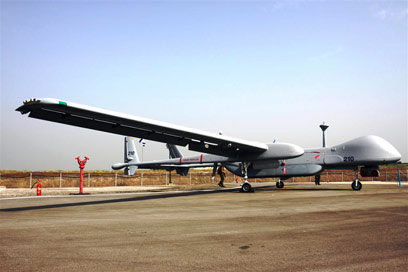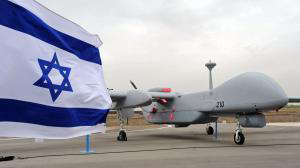Franck Znaty
**@*****fo.com
The Israeli Air Force (IAF) has enlisted this week a new recruit within its ranks: the Unmanned Aerial Vehicle (UAV) Eitan, which is a domestic version of the Heron TP developed three years ago for export purpose (it has been in particular used by French armed forces in Afghanistan). The UAV Eitan is the result of an IAF collaboration with the defense company Israel Aircraft Industries (IAA).

One of the largest on the market
This new UAV is described by the IAF as “major technological breakthrough”. The Eitan has a wingspan of 86 feet (26 meter) similar to that of a Boeing 737. It has a length of 79 feet (24 meters) and weighs close to 4.5 tons, which makes it one of the biggest UAV in the market. “The Eitan can stay in the air for more than 20 hours; it can carry very large cargo and fly very far, much further than any other unmanned drone in Israel” says IAF’s Lieutenant Colonel A..
Eitan’s endurance is similar to that of the US MQ-9 Reaper, the latest variant of the Predator drone, used in targeted killing missions against al Qaeda and Taliban leaders with AGM-114 Hellfire ground-to-air missiles. This endurance capacity is the biggest one the IAF has at its disposal in its UAV fleet. The “large cargo” evoked earlier by the IAF officer is 1 ton whereas most of the Israeli drones can carry a maximum weight of 250kg, reminds us Ynetnews.
Designed for high-altitude missions
Missions involving UAVs are taking a more prominent role within the IAF. Indeed, many operations once involving manned aircrafts are being handed over to UAVs squadrons, such as mission of intelligence gathering, escort or force protection. As indicated by Greenberg, in 2004 UAVs have registered 16,600 flight hours as this number jumped to 36,548 for the year 2009.The Eitan has already been used in missions such as during last year’s Cast Lead operation. As pointed out, by the Associated Press, the number of UAVs being purchased by the IAF is still unknown. A squadron will be especially put in place for operating the Eitan and will receive throughout the year a special training for its handling.
The Eitan will be used in high altitude along with other aircraft that will fly in lower altitude in missions involving long distance targets. According to Lieutenant Colonel Eytan, the IAF officer in charge of the Eitan project, this new aircraft “can complete a very wide range of missions, and adds specialized intelligence capabilities to the IAF. Very few UAVs in the world can reach its capabilities”. However, all these new capabilities come at a cost: “this aircraft has become much more expensive compared to its predecessors,” says another officer. “For that reason, we prepared a suitable ‘protective vest’ for it, so that it can cope with threats.”

A Useful Tool in the Arm-Wrestling Game with Teheran?
Despite the fact that many media and analysts describe this new Israeli capability as being able to reach and strike Iran, not everyone shares such a view and cautions that the drone “does not materially alter Israel’s ability to strike Iran.” The Stratfor analyst develops that in order to reach Iran, the aircraft will have to fly above the Iraqi airspace and he describes this as “the most politically sensitive” route because of the American presence. To avoid this ‘unpleasant’ fact, the drone will have to contort the Arabian peninsula and fly back to Israel, and the Eitan, adds the analyst, “does not have the capability” to do so.
However, were the Israeli leaders given a green light for a preemptive strike against Iran, the Eitan, estimate some observers, would come in handy for post-attack operations, such as battle damage assessment. Such a capability could indeed be a determining element in any operations mounted against the Iranian nuclear installation.
———-

